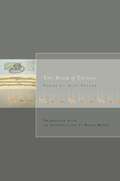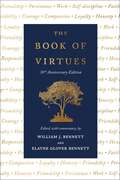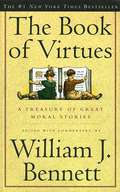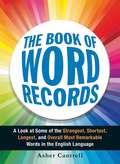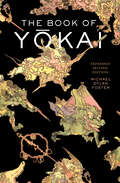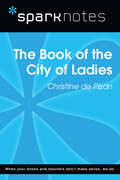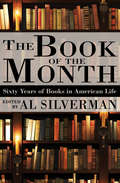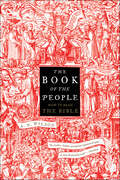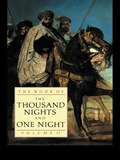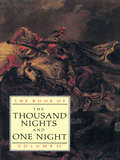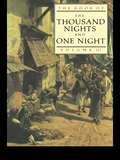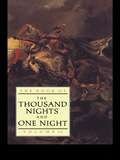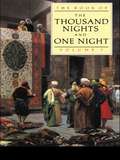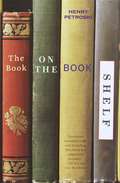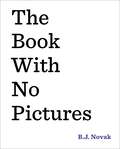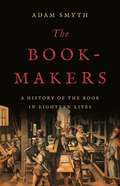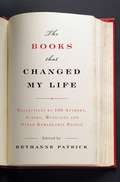- Table View
- List View
The Book of Things
by Brian Henry Ales StegerFrom his first book of poems, Chessboards of Hours (1995), Aleš Šteger has been one of Slovenia's most promising poets. The philosophical and lyrical sophistication of his poems, along with his work as a leading book editor and festival organizer, quickly spread Šteger's reputation beyond the borders of Slovenia. The Book of Things is Šteger's most widely praised book of poetry and his first American collection. The book consists of fifty poems that look at "things" (i.e. aspirin, chair, cork) which are transformed by Šteger's unique poetic alchemy.Translator Brian Henry is a distinguished poet, translator, editor, and critic.From Publisher's Weekly:Steger's efforts sometimes bring to mind such Western European figures as Francis Ponge and Craig Raine, who also sought to make household things look new and strange. Yet Steger brings a melancholy Central European sense of history- his objects tend to remember, or cause, great pain: "It pours, this poisonous, sweet force," Steger writes of "Saliva," "Between teeth, when you spit your own little genocide." (Nov.)From Guernica, a Magazine of Art and Politics:It is a rare treat to have an English translation before the ink has dried on the original. By which I mean, a mere five years after the book's Slovenian publication, Brian Henry has brought these poems to life for those of us not lucky enough to read Slovenian. Henry's translations are impressive for sheer acrobatics.
The Book of Things (Lannan Translations Selection Series #18)
by Ales StegerFrom his first book of poems, Chessboards of Hours (1995), Aleš Šteger has been one of Slovenia's most promising poets. The philosophical and lyrical sophistication of his poems, along with his work as a leading book editor and festival organizer, quickly spread Šteger's reputation beyond the borders of Slovenia. The Book of Things is Šteger's most widely praised book of poetry and his first American collection. The book consists of fifty poems that look at "things" (i.e. aspirin, chair, cork) which are transformed by Šteger's unique poetic alchemy.Translator Brian Henry is a distinguished poet, translator, editor, and critic.From Publisher’s Weekly:Steger’s efforts sometimes bring to mind such Western European figures as Francis Ponge and Craig Raine, who also sought to make household things look new and strange. Yet Steger brings a melancholy Central European sense of history- his objects tend to remember, or cause, great pain: "It pours, this poisonous, sweet force,” Steger writes of "Saliva,” "Between teeth, when you spit your own little genocide.” (Nov.)From Guernica, a Magazine of Art and Politics:It is a rare treat to have an English translation before the ink has dried on the original. By which I mean, a mere five years after the book’s Slovenian publication, Brian Henry has brought these poems to life for those of us not lucky enough to read Slovenian. Henry’s translations are impressive for sheer acrobatics.
The Book of Virtues: 30th Anniversary Edition
by William J. Bennett Elayne Glover BennettHelp your children develop moral character with this updated, 30th anniversary edition of the perennial classic Book of Virtues.Almost 3 million copies of the Book of Virtues have been sold since it was published in 1993. It is one of the most popular moral primers ever written, an inspiring anthology that helps children understand and develop character—and helps parents teach it to them. Thirty years ago, readers thought that the times were right for a book about moral literacy. Back then, Americans worried that schools were no longer parents&’ allies in teaching good character. As the book&’s original introduction noted, &“moral anchors and moorings have never been more necessary.&” If that was true in the 1990s, it is even more true today. The explosion of information with the Internet has left many unsure of what is valuable and what is not. Responsibility. Courage. Compassion. Loyalty. Honesty. Friendship. Persistence. Hard work. Self-discipline. Faith. These remain the essentials of good character. The Book of Virtues contains hundreds of exemplary stories offering children examples of good and bad, right and wrong. Drawing on the Bible, American history, Greek mythology, English poetry, fairy tales, and modern fiction, William J. and Elayne Bennett show children the many virtuous paths they can follow—and the ones they ought to avoid. For the 30th anniversary edition, the Bennetts have slimmed down the book&’s contents, while also finding room to introduce such figures as Mother Teresa, Colin Powell, and heroes of 9/11 and the War in Afghanistan. Here is a rich mine of moral literacy to teach a new generation of children about American culture, history, and traditions—ultimately, the ideals by which we wish to live our lives. The updated edition of The Book of Virtues will continue a legacy of raising moral children far into a new century.
The Book of Virtues: A Treasury Of Great Moral Stories (Book Of Virtues Collection)
by William J. BennettResponsibility. Courage. Compassion. Honesty. Friendship. Persistence. Faith. Everyone recognizes these traits as essentials of good character. In order for our children to develop such traits, we have to offer them examples of good and bad, right and wrong. And the best places to find them are in great works of literature and exemplary stories from history. William J. Bennett has collected hundreds of stories in The Book of Virtues, an instructive and inspiring anthology that will help children understand and develop character -- and help adults teach them. From the Bible to American history, from Greek mythology to English poetry, from fairy tales to modern fiction, these stories are a rich mine of moral literacy, a reliable moral reference point that will help anchor our children and ourselves in our culture, our history, and our traditions -- the sources of the ideals by which we wish to live our lives. Complete with instructive introductions and notes, The Book of Virtues is a book the whole family can read and enjoy -- and learn from -- together.
The Book of Word Records: A Look at Some of the Strangest, Shortest, Longest, and Overall Most Remarkable Words in the English Language
by Asher CantrellFrom antidisestablishmentarianism to zo, a unrivaled collection of today's greatest words!Have you ever wondered what the longest word in the dictionary is? Or the origin of your go-to curse word?With The Book of Word Records, you'll uncover hundreds of bizarre, ugly, gross, and otherwise extreme words that have what it takes to break some serious records. From the seven longest speeches ever given to twelve of the most popular passwords used today, each of these entries reveals the history behind the world's most noteworthy expressions and fascinating details on how they stack up against the competition. You'll also learn how to step up your vocabulary with pronunciations, definitions, and sample sentences for each award-winning word.Whether you're a Scrabble champ looking to get a high score or just want to impress those around you, The Book of Word Records is sure to surprise even the most skilled wordsmith with its one-of-a-kind superlative lists.
The Book of Yokai, Expanded Second Edition: Mysterious Creatures of Japanese Folklore
by Michael Dylan FosterSignificantly expanded and updated—a lively excursion into Japanese folklore and its increasing influence within global popular culture. Monsters, spirits, fantastic beings, and supernatural creatures haunt the folklore and popular culture of Japan. Broadly labeled yōkai, they appear in many forms, from tengu mountain goblins and kappa water sprites, to shape-shifting kitsune foxes and long-tongued ceiling-lickers. Popular today in anime, manga, film, and video games, many yōkai originated in local legends, folktales, and regional ghost stories. The Book of Yōkai invites readers to examine how people create, transmit, and collect folklore, and how they make sense of the mysteries in the world around them. Revised and expanded, this second edition features fifty new illustrations, including an all-new yōkai gallery of stunning color images tracing the visual history of yōkai across centuries. In clear and accessible language, Michael Dylan Foster unpacks the cultural and historical contexts of yōkai, interpreting their varied meanings and introducing people who have pursued them through the ages.
The Book of the City of Ladies (SparkNotes Literature Guide Series)
by SparkNotesThe Book of the City of Ladies (SparkNotes Literature Guide) by Christine de Pizan Making the reading experience fun! Created by Harvard students for students everywhere, SparkNotes is a new breed of study guide: smarter, better, faster.Geared to what today's students need to know, SparkNotes provides:chapter-by-chapter analysis explanations of key themes, motifs, and symbols a review quiz and essay topicsLively and accessible, these guides are perfect for late-night studying and writing papers.
The Book of the City of Ladies: Or The Book Of The Three Virtues
by Christine PizanChristine de Pizan (c.1364-1430) was France's first professional woman of letters. Her pioneering Book of the City of Ladies begins when, feeling frustrated and miserable after reading a male writer's tirade against women, Christine has a dreamlike vision where three virtues - Reason, Rectitude and Justice - appear to correct this view. They instruct her to build an allegorical city in which womankind can be defended against slander, its walls and towers constructed from examples of female achievement both from her own day and the past: ranging from warriors, inventors and scholars to prophetesses, artists and saints. Christine de Pizan's spirited defence of her sex was unique for its direct confrontation of the misogyny of her day, and offers a telling insight into the position of women in medieval culture. THE CITY OF LADIES provides positive images of women, ranging from warriors and inventors, scholars to prophetesses, and artists to saints. The book also offers a fascinating insight into the debates and controversies about the position of women in medieval culture.
The Book of the Courtier
by Baldesar CastiglionePeter Hainsworth's sparkling, eminently readable new English translation of The Book of the Courtier, Baldesar Castiglione's (1478–1529) literary and philosophical masterpiece, captures all the nuance, stylistic flair, and humor of this foundational work of Renaissance humanism.
The Book of the Honeycomb's Flow: Sepher Nopheth Suphim by Judah Messer Leon
by Isaac Rabinowitz Judah Messer LeonThe Book of the Honeycomb's Flow. Sepher Nopheth Suphim. A critical edition and translation by Isaac Rabinowitz.
The Book of the Month: Sixty Years of Books in American Life
by Al SilvermanThis collection of essays and reviews from the Book-of-the-Month Club offers a unique literary history of American readership in the twentieth century. From The Sun Also Rises to The Accidental Tourist, the judges, editors, and reviewers of the Book-of-the-Month Club help readers all across America find their next favorite book. In this comprehensive anthology compiled from the Club&’s monthly News, astute reviewers praise and critique a diverse array of authors including Dashiell Hammett, Barbara Tuchman, Sinclair Lewis, Saul Bellow, Margaret Mitchell, James Baldwin, Willa Cather, and Evelyn Waugh. Harper Lee affectionately profiles Truman Capote, poet laureate Robert Penn Warren praises his friend Bill Styron, and Gore Vidal interviews himself. John le Carré shares why it was particularly hard to write A Perfect Spy, and E. L. Doctorow reveals the intentions of his masterpiece, Ragtime. A celebration of the life-affirming power of the written word and a treasure trove of reviews, essays, and author portraits related to classic books we all know and love and less famous titles well-deserving of rediscovery, The Book of the Month is a must-read for bibliophiles everywhere.
The Book of the People: How to Read the Bible
by A.N. WilsonFrom renowned historian, biographer and novelist, A.N. Wilson, a deep personal, literary, and historical exploration of the Bible. In The Book of the People, A. N. Wilson explores how readers and thinkers have approached the Bible, and how it might be read today. Charting his own relationship with the Bible over a lifetime of writing, Wilson argues that it remains relevant even in a largely secular society, as a philosophical work, a work of literature, and a cultural touchstone that the western world has answered to for nearly two thousand years: Martin Luther King was "reading the Bible" when he started the Civil Rights movement, and when Michelangelo painted the fresco cycles in the Sistine Chapel, he was "reading the Bible." Wilson challenges the way fundamentalists—whether believers or non-believers—have misused the Bible, either by neglecting and failing to recognize its cultural significance, or by using it as a weapon against those with whom they disagree. Erudite, witty and accessible, The Book of the People seeks to reclaim the Good Book as our seminal work of literature, and a book for the imagination.
The Book of the Thousand Nights and One Night (Vol 2)
by Powys MathersFirst published in 1986. Routledge is an imprint of Taylor & Francis, an informa company.
The Book of the Thousand and One Nights
by J. C. Mardrus E. P. MathersFirst published in 1986. Routledge is an imprint of Taylor & Francis, an informa company.
The Book of the Thousand and One Nights
by J. C. Mardrus Powys MathersFirst published in 2013. An unabashed and accurate translation of the wonderful and enchanting tales of the Arabian Nights, complete in four volumes.
The Book of the Thousand and One Nights (Volume #3)
by J. C. Mardrus E. P. MathersFirst published in 1986. Routledge is an imprint of Taylor & Francis, an informa company.
The Book of the Thousand and One Nights (Volume #4)
by J. C. Mardrus Powys MathersFirst published in 1986. Routledge is an imprint of Taylor & Francis, an informa company.
The Book of the Thousand and one Nights. Volume 1
by J. C Madrus E. P MathersFirst Published in 1986. Routledge is an imprint of Taylor & Francis, an informa company.
The Book on Public Speaking
by Topher Morrison&“One of the most powerful professional speakers in America . . . reveals how he&’s earned millions onstage, on camera and in business&” (Steve Siebold, CSP, past chairman of The National Speakers Association&’s Million Dollar Speakers Group). If you look at the trends of over thirty years ago in fashion, technology, architecture, and any other industry, what was cutting edge back then has become cliché and grossly out of date now. But in the speaking industry, most people get up and still walk, talk, and sound like the 1980s motivational speakers of yesteryear. The Book on Public Speaking takes a head-on approach and challenges the status quo for business leaders that speak in front of their staff, board of directors, and the public. After reading this book you will be privy to the most current methods for speaking to an audience for maximum impact in today&’s more sophisticated and skeptical culture. If you are the type of business leader who has achieved a level of success in life and feel compelled to share your story with the world, don&’t lessen that impact by imitating outdated speaking techniques. Instead, break the mold of the speaker cliché and tap into a speaking style that is authentic, packs a punch, and leaves the audience wanting more. &“I learned some amazing presentation techniques from Topher. I&’m using them right now. They&’re awesome. You can&’t tell because you&’re reading this.&” —John Heffron, winner of The Last Comic Standing &“Morrison is crazy good at training you how to communicate on-camera so that your business gets more attention.&” —James Lavers, professional speaker, founder, &“Selling from the Screen&”
The Book on the Bookshelf
by Henry PetroskiFrom the author of the highly praised The Pencil and The Evolution of Useful Things comes another captivating history of the seemingly mundane: the book and its storage.Most of us take for granted that our books are vertical on our shelves with the spines facing out, but Henry Petroski, inveterately curious engineer, didn't. As a result, readers are guided along the astonishing evolution from papyrus scrolls boxed at Alexandria to upright books shelved at the Library of Congress. Unimpeachably researched, enviably written, and charmed with anecdotes from Seneca to Samuel Pepys to a nineteenth-century bibliophile who had to climb over his books to get into bed, The Book on the Bookshelf is indispensable for anyone who loves books.From the Trade Paperback edition.
The Book with No Pictures
by B. J. NovakA #1 New York Times bestseller, this innovative and wildly funny read-aloud by award-winning humorist/actor B.J. Novak will turn any reader into a comedian—a perfect gift for any special occasion! You might think a book with no pictures seems boring and serious. Except . . . here&’s how books work. Everything written on the page has to be said by the person reading it aloud. Even if the words say . . . BLORK. Or BLUURF. Even if the words are a preposterous song about eating ants for breakfast, or just a list of astonishingly goofy sounds like BLAGGITY BLAGGITY and GLIBBITY GLOBBITY. Cleverly irreverent and irresistibly silly, The Book with No Pictures is one that kids will beg to hear again and again. (And parents will be happy to oblige.)
The Book-Makers: A History of the Book in Eighteen Lives
by Adam SmythA scholar and bookmaker &“breathes both books-as-objects and their creators back into life&” (Financial Times) in this five-hundred-year history of printed books, told through the people who created them Books tell all kinds of stories—romances, tragedies, comedies—but if we learn to read the signs correctly, they can tell us the story of their own making too. The Book-Makers offers a new way into the story of Western culture&’s most important object, the book, through dynamic portraits of eighteen individuals who helped to define it. Books have transformed humankind by enabling authors to create, document, and entertain. Yet we know little about the individuals who brought these fascinating objects into existence and of those who first experimented in the art of printing, design, and binding. Who were the renegade book-makers who changed the course of history? From Wynkyn de Worde&’s printing of fifteenth-century bestsellers to Nancy Cunard&’s avant-garde pamphlets produced on her small press in Normandy, this is a celebration of the book with the people put back in.
The Booklover's Guide to New Orleans: An American POW in Germany
by Susan LarsonThe literary tradition of New Orleans spans centuries and touches every genre; its living heritage winds through storied neighborhoods and is celebrated at numerous festivals across the city. For booklovers, a visit to the Big Easy isn't complete without whiling away the hours in an antiquarian bookstore in the French Quarter or stepping out on a literary walking tour. Perhaps only among the oak-lined avenues, Creole town houses, and famed hotels of New Orleans can the lust of A Streetcar Named Desire, the zaniness of A Confederacy of Dunces, the chill of Interview with the Vampire, and the heartbreak of Walker Percy's Moviegoer begin to resonate.Susan Larson's revised and updated edition of The Booklover's Guide to New Orleans not only explores the legacy of Tennessee Williams and William Faulkner, but also visits the haunts of celebrated writers of today, including Anne Rice and James Lee Burke. This definitive guide provides a key to the books, authors, festivals, stores, and famed addresses that make the Crescent City a literary destination.
The Bookmaker's Daughter: A Memory Unbound
by Shirley AbbottShirley Abbott's deeply felt memoir of her Arkansas childhood in the 1940s and 1950s examines her difficult relationship with the most important man in her young life--her daddy. Alfred Bemont ("Hat") Abbott did not craft fine volumes, though he allowed Shirley's mother to believe as much during their courtship. His craft was taking bets on horses and paying off the winnings. But this gentleman bandit also loved to read and bequeathed to his only daughter the world of language and books, where she learned her first lessons in what it is to be a woman. At Hat's urging to study hard, to grow strong and independent, Shirley blossomed into valedictorian of her high school class, and unlike her peers--all on the way to marriage and motherhood--went fearlessly on to college. But when at last she wished to test her wings, to leave Hot Springs for New York City, Hat refused to let her go. Richly detailed with family anecdote, feminist insight, history, sociology, and Southern mythology, The Bookmaker's Daughter strikes familiar and resonant chords. Shirley Abbott has courageously probed the past to emerge with this narrative of a relationship that was complex and volatile but ultimately liberating. Born and brought up in Hot Springs, Arkansas, Shirley Abbott now lives in Port Washington, New York. She works in Manhattan as a writer for a health newsletter and has also written a previous book, Womenfolks: Growing Up Down South. She has two daughters, Katharine and Elizabeth Tomkievicz.
The Books That Changed My Life: Reflections by 100 Authors, Actors, Musicians, and Other Remarkable People
by Bethanne PatrickOne hundred of today's most prominent literary and cultural icons talk about the books that hold a special place in their hearts--that made them who they are today. Leading authors, politicians, CEOs, actors, and other notables share the books that changed their life, why they love them, and their passion with readers everywhere. Regan Arts has teamed up with the literary charity 826National, which will receive a portion of the book's proceeds to provide students ages 6-18 with opportunities to explore their creativity and improve their writing skills. Contributors include Al Roker, Carl Hiaasen, Dave Eggers, Emma Straub, Eric Idle, Fay Weldon, Fran Lebowitz, Gillian Flynn, Gregory Maguire, Jeff Kinney, Jim Shepard, Laura Lippmann, Lev Grossman, Liev Schreiber, Margaret Atwood, Mayim Bialik, Nelson DeMille, Rosanne Cash, Susan Orlean, Tim Gunn, and Tommy Hilfiger, among others.
